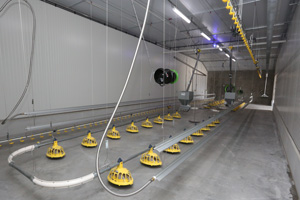Ultra-modern stalls for Experimental Poultry Centre

The Experimental Poultry Centre (EPC) in Geel, Belgium, has opened two new stalls: a laying hen house and a broiler stall. All together, EPC now has four stables for 37,600 broilers and 31,000 laying hens.
“The opening of these new stalls means we are ready to play our European role,” said manager Johan Zoons. “We now have the infrastructure to research parameters which are revolutionary for poultry farming. These ultra-modern stalls also enable us to look for answers relevant to today’s sector, but also to anticipate future legislation and challenges.”
Broiler stalls
The new broiler stalls have space for 18,000 extra broilers and consist of eight completely separate climate sections for 2250 broilers in each case. Each section has a separate climate regulator, which also registers all climate data. Outdoor air comes in via openings in the stall side wall. The air passes first through a conditioner zone where it can be heated or cooled. The outgoing air is sucked into two exhaust towers by means of ventilators. These towers have a space where it will be possible in the future to analyse techniques for air purification.
Laying hen stall
The new laying hen stall has a capacity of 31,000 laying hens. They are accommodated in the most modern systems and are subdivided into 12 experimental departments:
- 4 departments with an aviary where the laying hens can move upwards within the system.
- 4 departments with an aviary where the laying hens can move upwards outside the system.
- 4 departments with furnished cages.
Each department has a separate climate control. Part of the incoming air can be heated by a heat exchanger. Outgoing air is sucked away via a central channel to an exhaust tower. This is a computerised system which provides enough fresh air with minimal energy consumption. This makes it possible to recycle the heat, dry fertiliser more efficiently, and research techniques to reduce the emission of fine dust, ammonia, and other harmful substances.
Sorting and packing eggs
Eggs are collected automatically for each experimental group. This means the eggs in the various experimental groups can be compared to each other. They are transported via the central spindle belt to a brand new sorting and packing machine. This machine uses camera-technology to determine the quality of the eggs and it records this information for further analysis. After that, the eggs are sorted automatically and packed by one and the same machine.
Join 31,000+ subscribers
Subscribe to our newsletter to stay updated about all the need-to-know content in the poultry sector, three times a week. Beheer
Beheer








 WP Admin
WP Admin  Bewerk bericht
Bewerk bericht